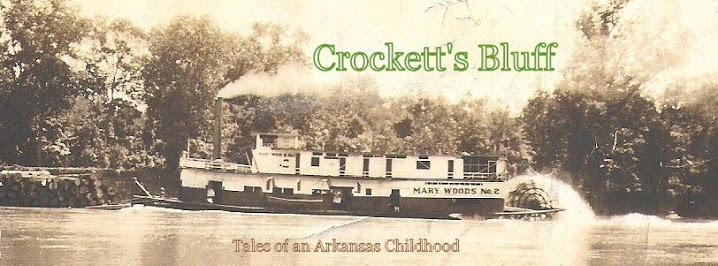The Adolph Prange family was arguably the largest and most prominent family in Crockett's Bluff from the late 1920s to the end of World War II. In 1929 they moved to their house west of the Prange Store that stood overlooking the White River and the riverside road that ran northward from Rt. 153 along the river embankment to what was generally known as the "steamboat landing." By the late 1930s and the war years, the older children gradually moved away from the Bluff, and in 1944 the store was closed and Adolph and Edna and the youngest children moved permanently to California.
Fortunately for us today, the Pranges believed in recording the activities and progressions of their family. From early "box" cameras on, they recorded the milestones of their lives. Like so many other images on this site, I'm indebted to Jim Prange, the son of James, one of the eldest of the clan, for many images of the family and the Bluff generally, as well as these videos.
Over the years, various members of the family paid visits to the Bluff, particularly for annual Fourth of July celebration. In 1995 they made a major - and for many, a final - pilgrimage to the Bluff that was faithfully recorded by a video camera. Jim was kind enough to transfer them to me via DVD. Though sections of them understandably vary in clarity, the sound is generally clear and the moments have been captured.
I
Part I begins with a windshield view from one of a caravan of Prange vehicles approaching from the west on Rt. 153 (the old Hill Road). David Prange moderates the first gathering on the bank of the White River at the old "Steamboat Landing." Stories and laughter. Afterward, there are similar stops at the site of the Prange Store and Schwab's Store and the Cemetery across from the old Post Office.
II
Part II returns to the old Prange homesite. General recollections of their memories of the Bethlehem Lutheran Church that stood nearby it. Gravesite of Adolph Prange's younger brother Bernard who died in his childhood. Lin "Hal" relates his memory of the day his parents left for California in his brother Joe's 41 Ford for California, and their stop for one final look back at their home and store. It ends with the arrival of the group at the Poplar Creek Missionary Baptist Church (which in part is composed today of the Lutheran Church that was moved west five miles or so to this spot) where other older friends and members of the community from the 1930s and 40s.
III
Parts III and IV, also moderated by Hal who opens their discussion with a poem "At Two O'Clock," after which he invites stories from the Prange siblings, as well as others in the gathering: Halley and Sikes Keithley, Lucille and Shelby Woodiel, Boone Bullock, and others. Two members of the Poplar Creek congregation - L.S. Stiggers and Roy Allan, both old friends of the Prange family - host the gathering, along with their Minister Rev. Williams. Boone relates the story of his dog Charlie and the cart he made that carried Hal as a young boy.
IV
Part IV continues the general discussion and concludes with Roy Allen's rendition of a folk hymn entitled "How Sweet It One Day Will Be."

